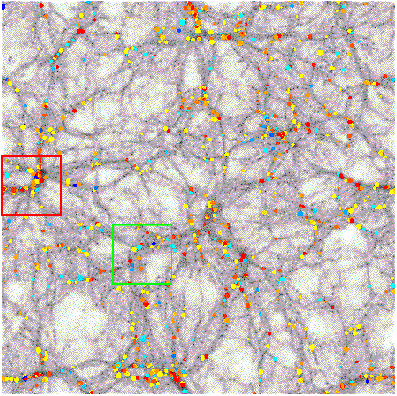Key Takeaways:
An international team of researchers from Japan, Taiwan, and the United Kingdom has provided the first direct and clear evidence for an extremely flattened shape of dark matter’s distribution in massive clusters of galaxies, a finding that confirms a major prediction of the prevailing dark matter model. The researchers took advantage of the gravitational lensing effect to make detailed measurements of the spatial distributions of dark matter in about 20 massive clusters of galaxies. A thorough examination of the shape of dark matter’s distribution in the cosmos may open up a new way to explore the nature of this enigmatic matter.
The nature of dark matter is still unknown and is currently a central problem in modern astronomy and physics. Dark matter is “dark” in a couple of ways. It is undetectable to visible light and has escaped detection at all electromagnetic wavelengths. Because it is invisible, its existence has to be inferred from its gravitational effect on other celestial objects as well as from theoretical models. Indirect evidence has established its relative abundance in our universe — probably 5 times greater than visible matter — in addition to its significance for understanding galaxy formation. For example, a considerable amount of dark matter probably sustains the structure of galaxies because the gravitational force of visible matter cannot bind its member stars. The scientific challenge is how to study the nature of dark matter. Astronomers seek ways to use their observations to solve this puzzle.
One approach to a solution is to make detailed measurements of the spatial distribution of dark matter and then compare the data to predictions drawn from theoretical models. Both aspects of this approach have their difficulties. How can scientists measure the distribution of dark matter? What are plausible assumptions to include in models of dark matter?
A team of astronomers led by Masamune Oguri, at the National Astronomical Observatory of Japan, and Masahiro Takada, at the University of Tokyo, decided to use gravitational lensing to measure and analyze the distribution of dark matter. Gravitational lensing provides a unique opportunity to explore dark matter distributions by measuring the distances that light travels from distant to foreground objects. Einstein’s general theory of relativity predicts that light from a distant object will bend around a massive object in the foreground, such as a cluster of galaxies or a concentration of dark matter. By measuring the distortion pattern of many distant galaxies, it is possible to infer the mass(es) of the object(s) in the foreground. Because the technique does not rely on assumptions about the visibility of the matter bending the light, gravitational lensing can be a powerful probe of dark matter.
The team fine-tuned their research by observing 20 massive clusters of galaxies with the Subaru Telescope’s Prime Focus Camera (Suprime-Cam). Clusters of galaxies are ideal sites for studying the distribution of dark matter because they contain thousands of galaxies and are known to accompany a large amount of dark matter. The superb light-collecting power and excellent image quality of the Subaru Telescope gave the researchers an extra advantage. By using Suprime-Cam at prime focus, they could capture objects in a particularly wide field of view.
Observations with Suprime-Cam yielded wide-field images of about 20 massive clusters of galaxies (typically located at 3 billion light-years from Earth), which the team then used to measure and analyze dark matter distributions. From their detailed analysis of gravitational lensing effects in the images, the team obtained clear evidence that the distribution of dark matter in the clusters has, on average, an extremely flattened shape rather than a simple spherical contour. The measured degree of the flattening is quite large, corresponding to 2:1 in terms of the ratio of major to minor axes of the ellipse. This finding represents the first direct and clear detection of flattening in the dark matter distribution with the use of gravitational lensing.
In addition to the promise of using gravitational lensing for exploring the nature of dark matter, this research contributes to theoretical modeling of dark matter. Detailed comparisons of the team’s findings with theoretical model predictions of the distribution of dark matter show that the observed degree of the flattening is in excellent agreement with theoretical expectations.
Theoretical predictions for dark matter distributions in clusters of galaxies are dependent on what kind of dark matter model is assumed. This research strongly supports the prevailing model, which begins with the assumption that dark matter consists of weakly interacting massive particles that are relics of the Big Bang. These particles are assumed to be “cold,” meaning thermal motions of the particles are negligibly small. According to this scenario, clusters of galaxies are dynamically young objects that form through the merging of many small objects. This theory predicts that the dark matter distribution in clusters of galaxies would be non-spherical, reflecting a large-scale structure of dark matter filaments — ribbons of cold material. Because the team’s findings confirm a non-spherical distribution, they demonstrate the feasibility of exploring the nature of dark matter via flattening in the dark matter distribution.
This study is a part of the Local Cluster Substructure Survey (LoCuSS), an international project carrying out a systematic study on galaxy clusters by combining the Subaru data with a wide range of data sets from radio, infrared, optical, and X-ray telescopes. The goal of the project is to reveal new aspects of cluster physics and cosmology. The results presented here are one of its initial achievements. More detailed explorations of dark matter in clusters of galaxies are planned using a wide-field survey with the Hyper Suprime-Cam, the next-generation prime-focus camera on the Subaru Telescope. These future studies will greatly improve our understanding of galaxy clusters and, hopefully, the properties of dark matter.










